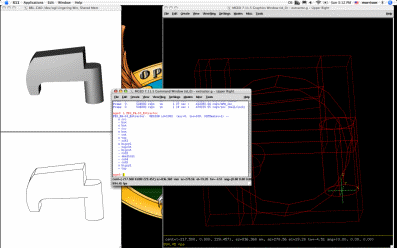

Other uses have included radiation dose planning, medical visualization, terrain modeling, constructive solid geometry (CSG), modeling concepts, computer graphics education and system performance benchmark testing.īRL-CAD supports a wide variety of geometric representations, including an extensive set of traditional implicit "primitive shapes" (such as boxes, ellipsoids, cones, and tori) as well as explicit primitives made from collections of uniform B-spline surfaces, non-uniform rational B-spline (NURBS) surfaces, n-manifold geometry (NMG), and purely faceted polygonal mesh geometry. government to help model military systems. The package has also been used in a wide range of military, academic, and industrial applications, including the design and analysis of vehicles, mechanical parts, and architecture. What is BRL-CAD?īRL-CAD (pronounced be-are-el-cad) is a powerful, cross-platform, open source solid modeling system that includes interactive three-dimensional (3D) solid geometry editing, high-performance ray tracing support for rendering and geometric analysis, network-distributed framebuffer support, image and signal-processing tools, path tracing and photon mapping support for realistic image synthesis, a system performance analysis benchmark suite, an embedded scripting interface, and libraries for robust high-performance geometric representation and analysis.įor more than two decades, BRL-CAD has been the primary solid modeling CAD package used by the U.S. Our contributors come from all over the world and use their diverse backgrounds and talents to help maintain and enhance one of the oldest computer-aided design (CAD) packages used in government and industry today. Welcome to BRL-CAD! Whether you are a developer, documenter, graphic artist, academic, or someone who just wants to be involved in a unique open source project, BRL-CAD has a place for you. For the ambitious, it might even be possible to go beyond lines and bound areas - this paper illustrates possibilities with layered 2D output from 3D models."The future exists first in the imagination, then in the will, then in reality." - Mike Muuss.From there, the set of xy points in image space could be fitted with spline curves to produce vector representations.


BRL-CAD can import and raytrace NURBS based models, and focusing on those as a starting point is a valid direction (the completion of the NURBS Boolean project would offer a path for CSG models via NURBS significant lines.) However, a possible alternative approach to directly deal with CSG models is to take the grid results of the rtedge raytrace and use the knowledge inherent in the ray about what object it's returning the pixel from to group pixels into groups based on objects. Without explicit surface representations we cannot (currently) calculate vector forms of significant lines () directly from models using CSG without using raytracing. This is often suboptimal - line drawings are often edited and rescaled using vector based editing programs, and rtedge output must be manually traced in order to be used in those environments. BRL-CAD can render hidden line drawings using rtedge, but the images it generates are raster images (consisting of pixels) rather than vector drawings (based on lines and curves).


 0 kommentar(er)
0 kommentar(er)
